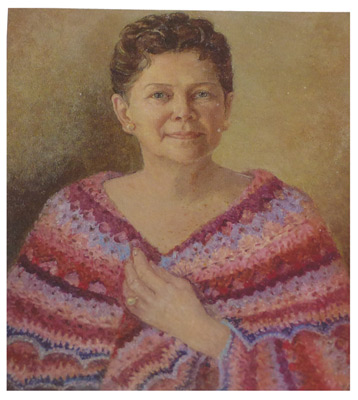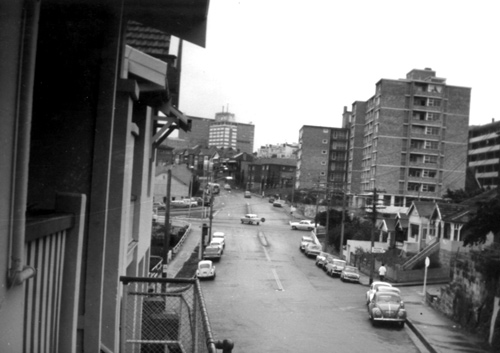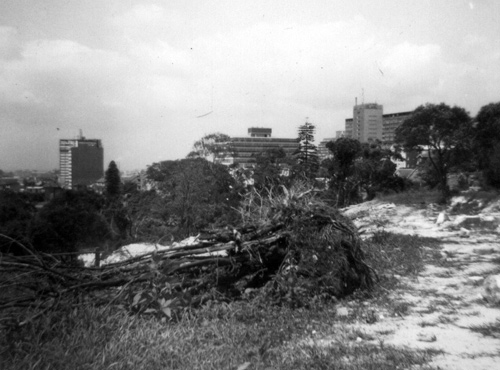Alexandra Alexandrovna Asovtseff emigrated to Australia with her husband in August 1954, the year that the new Queen of England visited. Although of Russian descent, for most of her life Alexandra had lived in China. After a short time at Bondi, she and her husband bought a house across the harbour at Neutral Bay.
From there Alexandra began to re-establish her career as an artist, a vocation in which she was already proficient and had shown great devotion. ‘There is nothing in life,’ she is quoted as saying, ‘that I value more than art.’ She possessed a genuine love of nature and many of her paintings expressed this.
Having lived for most of her life away from her country of birth and arriving as a refugee, she empathised with those who lived on the fringes of society. She understood what it meant not to belong. It was therefore not surprising that some of her first subjects in Australia were the Aboriginal people who lived at La Perouse.
Neutral Bay is considered part of the larger district of North Sydney. The construction of the Warringah Expressway during the 1960s saw this area undergo great changes. Alexandra realised the value and urgency of recording these changes to her surroundings. It seems that she was growing to regard North Sydney as not only familiar but also essential to her sense of belonging. The result was a series of drawings and paintings capturing the Expressway’s impact on her neighbourhood.

In some of these paintings she included the new building towers which were starting to sprout on the North Sydney skyline. They seem to loom ominously in the background of her paintings. The light pastel shades and bland aesthetic of these new high rise structures contrast starkly with the earthy tones of the buildings, already in stages of demolition, because of the coming expressway.
Pine Trees and Building, painted in 1962, is one such example. From memory, I think this is a view of Alfred Street. The two storey brick facade reminds me of the flats where a friend of mine once lived. It could in fact be the remains of those flats. In the painting we look through the windows and realise that the rest of the building is gone. The brick letter boxes at the entrance are still there, waiting for mail that will no longer be delivered.
View from Alfred Street , painted in 1964, has another new high rise building lurking in the background. The warm tones of the older buildings in the foreground make us wonder how many of these buildings survived the expressway’s ravages.
Waiting for the phone, painted around 1965, features a bright red phone box in the foreground and a woman, sitting on a low brick wall, waiting to use the telephone. For people who lived at this time, there appears nothing unusual about this. My family, like many others, had no home phone for a large part of my childhood. We relied on the public telephone, even if it meant we had to wait our turn.
Alexandra’s paintings successfully capture such ordinary, daily routines like this. To the right of the picture is a bulldozer, as if resting for the night. Buildings fill the picture and the dark skyline seems to prophesy the uncertain future that awaits them in the morning. A solitary light shines from a window and we are prodded into suspecting that most of these buildings have already been vacated. They are indeed ready for demolition!
For one who so much enjoyed the Saturday afternoon matinees and all the wonderful memories associated with them, Demolition of the Orpheum Theatre, painted in 1963, is exactly what its title states. Important places in our lives were disappearing forever. In this painting, Alexandra reminds us how narrow the Pacific Highway actually was . We also get a glimpse of the Continental Hotel’s awning as it fronted Alfred Street, another significant building awaiting its removal from the landscape.
Around 1974 Alexandra painted Undercliff Street at sunset. She lived in this Neutral Bay street and the painting possibly captures the North Sydney skyline that she would have seen directly from her home. In the background the MLC building glows with an intensity increased by the pinky smudges from the setting sun. For me it is a simple detail in this picture that speaks volumes – the weather beacon is showing red, the sign for bad weather to come. During my childhood, the beacon was clearly visible to most parts of the suburb. Adorning the MLC building, which was positioned on Victoria Cross, a high part of North Sydney, the beacon’s lights communicated widely.
In 2011 I visited Undercliff Street and stood before Alexandra’s former residence. From the roadway, I was unable to see the MLC building. I doubt whether, from the vantage of her former home, I would have had more success. So many buildings and trees now filled the landscape that she had once painted.
Alexandra travelled the district by foot, carrying her art materials in a shopping trolley which also improvised as an onsite easel. My visit to Undercliff Street made me realise how far she actually walked in her efforts to paint her changing suburb. Her house is located on a ridge and most of her travels would have been up and down hills, some with rather steep ascents. I often wonder whether I ever saw her as I too walked around the same neighbourhood, but with younger legs.
After her death in December 1994, according to her wishes, a book about her life and art was written by Anastasia Cox and published in 1997. I guess this was her humble way of trying to insure that her life and work would not be forgotten. And it was a copy of this book that first introduced me to this very interesting and talented lady. In July 2010 I wrote a song about her. I hope, in some small way, it also helps to keep her memory and vision alive.
© Jim Low
- Listen to the song above – Alexandra’s Pictures
- Read the lyrics




